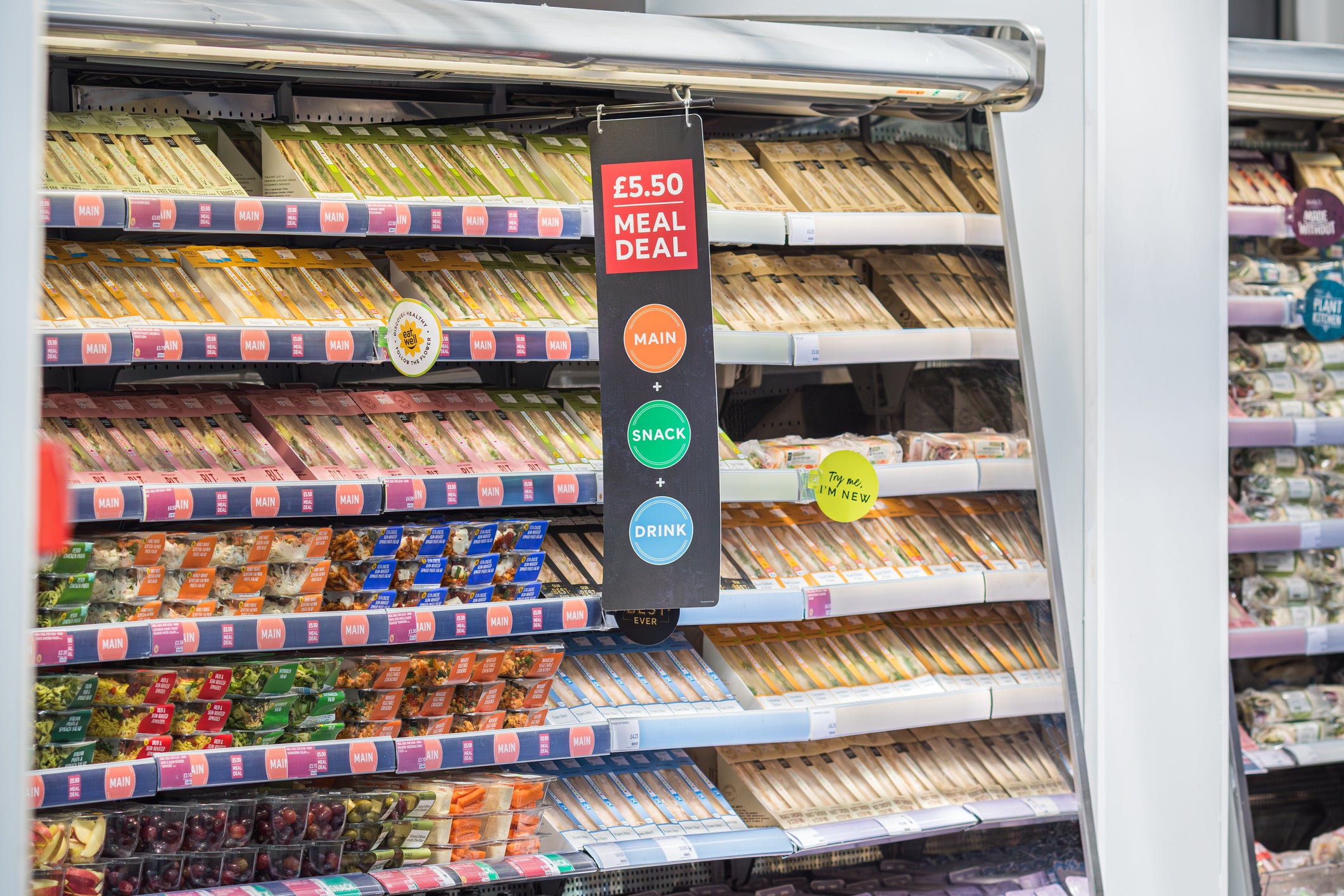A sandwich is defined by its simplicity. Two pieces of bread, a filling that could be as straightforward as two slices of cheese, lettuce, some tomato, and that’s it. Boom: lunch. Easy to make, quick to eat, and convenient to buy, the sandwich has historically dominated the market for hurried workers looking for an on-the-go bite. Its biggest draw, though, has always been the price.
There was a time when sandwiches from a supermarket or from the high street were reasonably priced, with some even under £2. Now, such things are as rare as coffees costing less than a fiver. At Pret a Manger, the humble sandwich has become a luxury item, with some priced as high as £6.25 (the chicken, avocado and basil). According to Bloomberg data, the chicken caesar and bacon baguette has increased by about 32 per cent since 2021, going from £3.99 to £5.25 in some parts of central London.
Meanwhile, M&S recently came under fire for its “posh” egg mayo and watercress sandwich, which was priced at £6, making it more than twice as expensive as the supermarket’s standard egg and cress sarnie despite containing just 51g more filling. Still, it’s a better landscape than at my local Waitrose, where a basic egg mayo and cress sarnie costs £3.10, while a smoked salmon and cream cheese flavour comes to a whopping £5.40.
At Tesco, prices are cheaper, with a bbq chicken, bacon and cheese sandwich priced at £3. And I did find a few options for under £3 at Sainsbury’s – chicken and sweetcorn is £2.60. Frankly, though, the sandwich looks so pallid and pathetic I’m not sure anyone would feel remotely tantalised by the prospect. Likewise at Co-op, where a cheddar cheese sandwich for £1.90 looked so inedible it almost warranted its own warning label. Still, sandwiches remain incredibly popular, with just three per cent of UK adults claiming to dislike them – 49 per cent said they liked sandwiches while 33 per cent claimed to love them, according to a YouGov survey from December.
It does make sense that, much like everything else, sandwiches are getting more expensive. Explanations aren’t hard to find: inflation, Brexit, the strain that Covid-19 put on businesses. “It’s also because of the rising costs of ingredients and labour,” says Jim Winship, director of The British Sandwich & Food to Go Association. “With the latest rise in employment costs, more increases are inevitable.” But Winship stresses that the increases have been in line with other foods. “The average cost of a sandwich is just over £3 – but you will always find outlets, like Pret, that cater for the higher spend market.”
That may well be the case. But mere price increases are not the only major changes facing the sandwich industry. A global glow-up is afoot. Thanks to the proliferation of experimental food trucks and food influencers, the sandwich has become a gourmet item.

Search “sandwichtok” on TikTok and you’ll quickly see what I mean. Whether or not these sarnies are made at home is irrelevant, the point is just how markedly luxurious they all are: think fillings twice as thick as both slices of bread combined, paired with indulgent ingredients used in unexpected and creative ways, ranging from pistachio pesto paired with buffalo chicken, and lobster combined with premium beef. You can buy sandwiches like this offline, too, most notably at the likes of Sandwich Sandwich, the wildly popular Bristol-born chain that is famed for its decadent fillings ranging from leg of lamb with whipped feta to battered cod and potato rosti.
“People choose us over supermarkets because we offer a truly personal experience,” says Nick Kleiner, founder of Sandwich Sandwich. “We’re still a hands-on, family-run business, and that authenticity is something customers can feel.” They sure can, if for a hefty price: the cheapest sandwich on offer is £6.95. Still, that’s not quite as dear as the infamous £28 sandwich at Harrods, which the luxury retailer launched (to great disdain) in 2023. A wagyu beef butty made with truffle butter and “gold” mustard mayo lodged between two pieces of sourdough, the sandwich was seen by many as a totem of an increasingly ludicrous market.
“No longer just a grab-and-go afterthought, today’s sandwiches are all about quality,” says Jason Geary, master baker at Jason’s Sourdough, which has expanded its offerings beyond loaves to a line of toasties and hot rolls designed to reach a more premium market. “People want artisan bread with real character, fresh ingredients and bold flavour combinations that actually taste like something and that make every bite count. The era of limp, lifeless sandwiches is over.”
Max Halley, founder of the cult north London hotspot Max’s Sandwich Shop, agrees that the past five years have seen the birth of a major premium market. “I think sandwiches have become genuinely delicious and not just about convenience,” he says. “People are putting truly delicious things they’ve cooked themselves into sandwiches, often in bread they’ve made themselves, rather than just assembling them from bought-in products. I think people have realised that a sandwich can be a meal, and a really delicious one at that.”
At Max’s, all the sandwiches are priced at £12.95, with costs only changing in line with its suppliers. The most popular filling is ham, egg ‘n’ chips. “Although we do a lasagna sandwich sometimes,” he adds, “which tastes like lasagna rather than having lasagna in it, that outsells [everything else] some weeks it’s on the menu.”
Some retailers feel as if the rise of the gourmet sarnie is the necessary result of having been driven out of the classic sandwich market due to changing consumer habits. “Customers now can go into any supermarket and buy a sandwich, which years ago wasn’t a thing,” says Philip Inzani, owner of Polo Bar, the iconic London cafe that has been serving food and drink outside Liverpool Street Station since 1953. Its menu includes a fish finger bloomer sandwich (£6.80) and a veggie club sandwich (£10.50). “We do not sell traditional sandwiches as we used to, as we’re finding that the market for these has gone to the supermarkets and larger chains,” he says. “We’ve therefore had to come up with a range of sandwiches that are different while still being competitively priced and of course excellent in taste, using different breads and warming methods.”
You can’t just serve the same thing for ever and ever. A boring, cold, pre-made three-day-old sandwich is not good enough
It wasn’t always like this. Let’s go back to 1980, when Marks & Spencer made history as the first retailer to sell a packaged sandwich, with prices starting at just 43p. It was a revelation – given that, until then, sandwiches were predominantly sold at bakeries, where cling film or greaseproof paper was used to somewhat feebly maintain freshness. M&S rolled out prepackaged versions that enabled them to stay fresh all day. The first filling was – somewhat surprisingly – salmon and tomato. Prawn mayo followed in 1981 and continues to be the retailer’s bestseller.
“Since then, sandwiches have only grown in popularity to the juggernaut they are today, selling around a quarter of a million per day in M&S every day of the year,” says Owen Lilley, product developer for M&S sandwiches. Filling options have continued to evolve, tailoring to changing gourmet taste buds, with recent additions including three-bird roast sandwiches, king prawn charcoal buns with a dressing in a syringe, and chorizo stuffing Christmas sandwiches. New varieties are introduced around six times a year.
“While we’ve kept some of our staples like ham and mustard and the BLT for decades now, we know our customers also like to try new things, especially flavours they might have tried at restaurants or street food markets,” says Lilley. “That’s why we introduce a new limited-edition sandwich or wrap every few months that will tap into the latest food trends.”
All this makes sense when you think about how lunchtime habits have changed more generally in the last few years. For starters, we’re a much more health-conscious nation. But we also crave more than we once did. “All of us who work in a big city are looking at lunchtime for three things: value, quality and convenience,” says Julian Metcalfe, co-founder of Pret a Manger and founder of Itsu. “That hasn’t changed. What has changed are people’s expectations: they’ve travelled much more than they had 45 years ago, for example. Coronation chicken was quite exotic. That’s no longer the case; everyone has had to up their game enormously.” Of course, this is difficult with rising costs across the board. “There’s an opportunity for people to be really creative and very focused.”
If they aren’t, Metcalfe predicts that the sandwich will fall out of fashion. At least in its original, somewhat simpler and plainer, iteration. “If you’re going to be successful on the high street, you’ve got to have a lot of innovation and keep being brave,” he explains, before espousing the rising demand for hot lunches that are “healthy and affordable”. “You can’t just serve the same thing for ever and ever. A boring, cold, pre-made three-day-old sandwich is not good enough.”
Perhaps the inevitable conclusion is that current trends for sandwiches will become increasingly polarised: at one end, the simple sandwiches will get simpler (think those pallid egg mayo offerings); at the other, we can expect rising costs alongside more elaborate creations. Cue £28+ wagyu beef sarnies. “The evolution of the sandwich isn’t about pushing it into the luxury space; it’s about raising the bar to meet what people now demand,” says Geary. “Because, let’s be honest: why would anyone go back to soggy white bread and a wilting lettuce leaf, when they’ve had the good stuff?”







